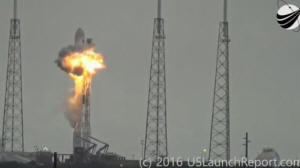|
SpaceX blast investigation suggests
breach in oxygen tank's helium system
 Send a link to a friend
Send a link to a friend
 [September 24, 2016]
By Irene Klotz [September 24, 2016]
By Irene Klotz
DALLAS (Reuters) - A SpaceX rocket that
burst into flames on its launch pad at the beginning of this month
likely suffered a large breach in its upper-stage helium system, the
company said on Friday.
SpaceX, owned and operated by technology entrepreneur Elon Musk, was
fueling a Falcon 9 rocket on the launch pad in Florida on Sept. 1 in
preparation for a routine test-firing when a bright fireball suddenly
emerged around the rocket's upper stage.
"At this stage of the investigation, preliminary review of the data and
debris suggests that a large breach in the cryogenic helium system of
the second stage liquid oxygen tank took place," SpaceX said in a
statement posted on its website.
SpaceX spokesman Dex Torricke-Barton declined to speculate on what
triggered the breach of the helium system, saying the company was still
investigating a range of possible causes.
No one was hurt in the explosion, which could be heard 30 miles (48 km)
away from SpaceX's launch pad 40 at Cape Canaveral Air Force Station.
The cause of the accident is under investigation.

SpaceX said it had learned enough to conclude that whatever triggered
the fireball was not related to a June 2015 accident that occurred about
two minutes after liftoff. That accident destroyed a load of cargo
heading for the International Space Station.
The company traced that problem to a faulty bracket that was holding a
bottle of helium in the oxygen tank of the rocketís upper stage. SpaceX
replaced thousands of brackets throughout its fleet and resumed flying
six months later.
"We have exonerated any connection with last year's Ö mishap," SpaceX
said in Friday's statement.
[to top of second column] |

An explosion on the launch site of a SpaceX Falcon 9 rocket is shown
in this still image from video in Cape Canaveral, Florida, U.S.
September 1, 2016. U.S. Launch Report/Handout via REUTERS/File Photo

The Sept. 1 launch pad fire damaged "substantial areas" of SpaceX's
primary launch site but key areas were unaffected. The company did
not provide an estimate of what repairing the damage would cost, nor
how long it would be out of service.
Pad 40 would be repaired, Torricke-Barton said, adding it was too
early to say when it would be completed.
The California-based firm said it would shift some missions to a new
launch site at NASA's Kennedy Space Center, adjacent to the Air
Force base. SpaceX also operates a launch site at Vandenberg Air
Force Base in California, which it uses for high-inclination and
polar-orbiting missions.
The company is aiming to resume flights in November.
SpaceX has more than 70 missions on its manifest, worth more than
$10 billion, for commercial and government customers.
(Additional reporting and writing by Alexandria Sage; Editing by Dan
Grebler and Sandra Maler)
[© 2016 Thomson Reuters. All rights
reserved.]
Copyright 2016 Reuters. All rights reserved. This material may not be published,
broadcast, rewritten or redistributed. |